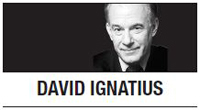[David Ignatius] Trump’s zig-zag course to Singapore
By David IgnatiusPublished : May 30, 2018 - 17:16
 “Are you on the road or in the ditch?” That’s the question labor reporters used to ask about big contract negotiations back when I covered the United Steelworkers union 40 years ago in Pittsburgh -- and it’s the right one to pose now as US President Trump zigs and zags toward a summit meeting with North Korean leader Kim Jong-un.
“Are you on the road or in the ditch?” That’s the question labor reporters used to ask about big contract negotiations back when I covered the United Steelworkers union 40 years ago in Pittsburgh -- and it’s the right one to pose now as US President Trump zigs and zags toward a summit meeting with North Korean leader Kim Jong-un. Trump and Kim appear to be firmly back on the road to a June 12 meeting in Singapore, after a near-death experience last week. Trump sent his coy breakup letter last Thursday (“very much looking forward” to seeing Kim but hurt by his “tremendous anger”). North Korea wafted back a flattering appeal to reconsider (“We have inwardly highly appreciated President Trump”). Result: Summit back on.
Trump’s temperamental swings along the way are familiar to anyone who has covered labor talks (maybe real estate negotiations are the same way, too). Over the past year, we’ve seen the full repertoire of bombastic bargaining: threatened walkouts, eleventh-hour reversals, oscillating taunts and flattery, and unbridgeable gaps that mysteriously get bridged.
A volatile negotiating style is sometimes a sign of an inexperienced or uncertain bargainer, notes the chief negotiator for one of America’s major unions. He explains in an interview that changing priorities and inconsistency are “inevitably taken as lack of commitment to the process and a sign of weakness” by negotiators and mediators. But it’s Trump’s approach, and however bizarre the route, he’s nearing a diplomatic breakthrough.
Through it all, Trump has kept returning to his baseline: He wants a deal, but he isn’t willing to alter his demand for denuclearization. North Korea made a series of concessions, including releasing hostages, without any reciprocal US easing of sanctions. “We’re controlling the pace,” insists one key US official. And, for now, this approach seems to be working.
What comes next? What are the fixed “red lines” for each side and where’s the wiggle room? How will an initial framework agreement be translated into specific commitments, and how will these be monitored? How will North Korea be rewarded for its compliance, in removal of sanctions and foreign investment? I couldn’t get clear answers from US or South Korean officials, maybe because there aren’t any yet.
The summit seems to have two framing ideas, which are likely to be at the heart of any final communique. North Korea will commit to “complete denuclearization.” The US will pledge to help transform North Korea into a modern, prosperous nation. Trump has conceded that denuclearization won’t happen instantly. As he put it last Wednesday: “I’d like to have it done immediately. But, you know, physically, a phase-in may be a little bit necessary.”
Phasing is necessary partly because the denuclearization process could take a decade, according to a report released Monday by Stanford University.
But the US official cautions against assuming this “phasing” will follow “the old playbook” -- the “synchronicity” and “freeze for freeze” ideas that animated previous deals with North Korea that failed. “We will know what reciprocated good faith looks like when we see it,” says this official, stressing Trump’s desire that the US not be tricked again by North Korea’s promises, as it was in the past.
US officials indicate that it’s too early to talk about easing sanctions or rewarding North Korean behavior. The trust isn’t there yet.
The Trump-Kim dynamic has developed enough momentum over the past year to survive last week’s shock. From his first day in office, Trump has seen North Korea as his biggest test, and he hungers for the deal that escaped his predecessors. This desire -- the inner voice chanting “Nobel Prize!” -- leaves Trump vulnerable to compromise, but with his breakup letter, he’s shown that he can walk away from the table if the terms aren’t right.
For Kim, the momentum is embedded in the process of modernization and change he began outlining in 2013, two years after becoming leader. His images of a modern nation were shaped by his teenage years as a student in Switzerland; clearly, this idea of transformation remains powerful for him. Building nuclear weapons was part of the vision; but he told the Korean Workers’ Party in April that it was now time to pivot and focus “all efforts” on economic development.
Will Kim really give up the bargaining chip that brought him to the door of a meeting with an American president? It sounds unlikely. But that’s the Singapore bargain, and if it can’t be reached, well, one thing you learn covering labor negotiations is that although strikes can bring devastating harm to both sides, they happen if talks collapse.
By David Ignatius
David Ignatius can be reached via Twitter: @IgnatiusPost. -- Ed.
(Washington Post Writers Group)







![[KH Explains] Hyundai's full hybrid edge to pay off amid slow transition to pure EVs](http://res.heraldm.com/phpwas/restmb_idxmake.php?idx=644&simg=/content/image/2024/04/18/20240418050645_0.jpg&u=20240419100350)






![[From the Scene] Monks, Buddhists hail return of remains of Buddhas](http://res.heraldm.com/phpwas/restmb_idxmake.php?idx=652&simg=/content/image/2024/04/19/20240419050617_0.jpg&u=20240419175937)

![[KH Explains] Hyundai's full hybrid edge to pay off amid slow transition to pure EVs](http://res.heraldm.com/phpwas/restmb_idxmake.php?idx=652&simg=/content/image/2024/04/18/20240418050645_0.jpg&u=20240419100350)

![[Today’s K-pop] Illit drops debut single remix](http://res.heraldm.com/phpwas/restmb_idxmake.php?idx=642&simg=/content/image/2024/04/19/20240419050612_0.jpg&u=)